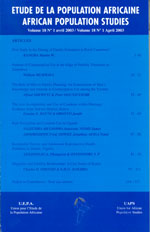
|
African Population Studies
Union for African Population Studies
ISSN: 0850-5780
Vol. 23, No. 2, 2008, pp. 173-188
|
 Bioline Code: ep08010
Bioline Code: ep08010
Full paper language: English
Document type: Research Article
Document available free of charge
|
|
|
African Population Studies, Vol. 23, No. 2, 2008, pp. 173-188
| en |
Situations of fertility stall in sub-Saharan Africa
Garenne, Michel
Abstract
A comparative study of fertility trends since 1950 in 30 countries from sub-Saharan
Africa revealed several cases of "fertility stall", that is a change from downward
fertility trends to flat- or even slightly rising- trends for some time, usually a few years:
Ghana (1998-2003), Kenya (1995-2003), Madagascar in urban areas (1987-1993), Nigeria
(1999-2003), Rwanda in rural areas (1999-2005), Tanzania in rural areas (1995-2004). In a
first part, the paper presents the statistical evidence of changes in fertility trends. In a
second part, the analysis focuses on possible causes of these changes. Fertility stalls
were often associated with changes in two proximate determinants (contraceptive use
and age at marriage) and in two socio-economic correlates (income and labour force
participation). The paper concludes to a variety of situations leading to different
causality in the various countries, including one case (Ghana) for which no reasonable
explanation could be found from the available data.
Keywords
Fertility transition; Fertility stall; Contraception; Labour force participation; Sub-Saharan Africa.
|
| |
| fr |
Garenne, Michel
Résumé
L'analyse des tendances de la fécondité dans 30 pays d'Afrique sub-saharienne révèle
plusieurs cas de stagnation de la transition, c'est-à-dire un changement d'une pente
négative à une pente nulle voire légèrement positive. Ces situations sont récentes et de
courtes durées : Ghana (1998-2003), Kenya (1995-2003), Madagascar en urbain (1987-
1993), Nigeria (1999-2003), Rwanda en rural (1999-2005), Tanzanie en rural (1995-2004).
La première partie montre la réalité statistique de ces changements de tendance. La
seconde partie analyse les causes possibles de ces changements. Les cas de stagnation de
la transition sont souvent associés aux changements de tendances de deux déterminants
de la fécondité : la contraception et l'âge au mariage, ainsi qu'à celles de deux corrélats
socio-économiques : le revenu et l'emploi féminin. Mais chaque situation semble
particulière et le résultat de causes différentes. Le cas du Ghana reste problématique et
inexpliqué.
Mots Clés
Transition de la fécondité; Stagnation de la transition; Contraception; Emploi féminin; Afrique sub-saharienne.
|
| |
© Copyright 2008 - Union for African Population Studies
Alternative site location: http://www.uaps-uepa.org
|
|
